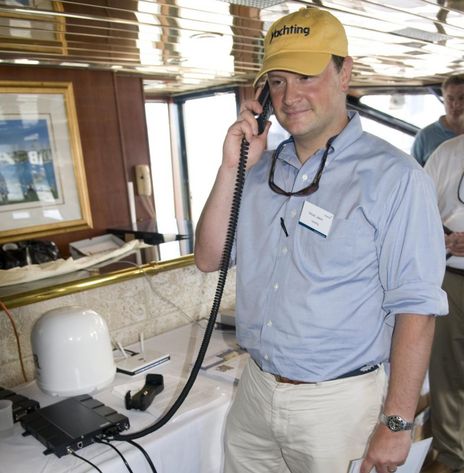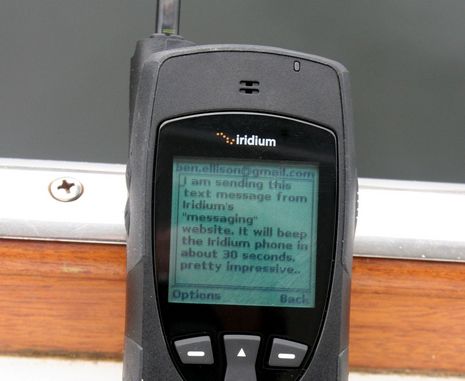Fleet Broadband 150, the Miami intro
I’m in a gang now, sort of, and I like it. Above is my Yachting magazine colleague Jason Wood calling me via FB150 sat phone from the Inmarsat demo boat on Biscayne Bay Monday, photographed by colleague John Brownlee, editor of Salt Water Sportsman. Yesterday I talked and texted via the loaner Iridium 9555 handset with two other members of the gang, SWS electronics guy Glen Law and Sport Fishing electronics gal Chris Woodward. We are testing electronics together, or at least comparing notes, and that’s good…
At any rate, there did seem to be a somewhat annoying delay in the FB150 call I got from Jason, but we can both be fast responders. Overall, Jason was impressed: “Based on the calls I made, I thought the sound quality was very good:
loud and clear. The slight delay — which seemed to cross up a couple of
eager talkers like us — took a bit of getting used to.” And, in answer to my question about the FB150’s Internet abilities, he added:
Yes, the guy who demo’ed had a real-time stock market page running and
share-price changes were ticking through as fast as you please. He also streamed radio and video. The
video got a little choppy, a live feed of the UK office (which was
closed) with just an oscillating fan with streamers tied to it, blowing
in the breeze. And he video conferenced us with that office, sort of a
picture-in-picture view of us.
Another cool aspect is that the FB150 will do SMS text. That’s text messaging,
but also is used in the corporate world for conferencing — very
effectively and efficiently. It does a lot of the things that your
mobile phone does, that you get accustomed to and may wish all your
handsets do: push-to-talk, for example. I don’t use it, but I know
many people who rely on it, like back country
fishing guides.
John Brownlee simply reports, “Yes, it worked remarkably well. Still pricey though.” Unfortunately the precise parameters of “pricey” are still unknown. The Inmarsat press release says that the terminals will be “sub-$5000″ but KVH says that hardware, and air time costs, are still undetermined. The hardware itself is also a little confusing. Inmarsat used the Sailor brand Thrane & Thrane dome in Miami; I think KVH will be using the same Thrane & Thrane internal hardware, but in a TracVision M1 style dome for its TracPhone 150; and there’s another terminal called the Skipper 150 I’ll report on soon. The most important thing about FB150 is that even a smallish boat can have voice and fast Internet comms anywhere, if the associated wallet is deep enough.















FB150 or Open Port, the cost of the equipment is virtually irrelevant. It’s the cost of the service that defines the product and nobody seems to want to discuss the $/MB yet. I will be very surprised if the pricing will allow internet browsing for even 100x the price of what we’re used to spending on land.
For example, a $5,000/yr BGAN contract buys you 1,200MB (1.2GB). Sounds like a lot, but keep track of your traffic sometime and I think you’ll be shocked at how little that represents. I’m connected through a fairly slow WiFi connection anchored off a small Caribbean island and I’ve had 1.6GB of traffic since this morning. Oops, that would have been more than my annual allotment of BGAN for $5,000!
I’d be curious to hear if there is any Panbo reader who is spending, or just waiting to spend, their own money on data at that price.
Good point, Russ. Plus I just learned that the “sub $5000” figure Inmarsat is quoted above is a wholesale price. It looks like FB150 terminals are going to retail somewhere between 6 and 7,000 dollars.
Me, I’m very pleased to find that I can get a good commercial WiFi connection at my Camden float with just the radio built into my laptop. But I do plan to try higher power WiFi, and also cellular data gear, for coastal cruising.
On Visions of Johanna we have installed an iridium openport system supplied by Globe Wireless. Voice is quite good and reasonably priced at about $0.75/min (with 100 min included in our $73 montly fee) and data charged at $13.20/MB This is certainly expensive, but when I did the math, normal iridium ends up costing almost $100/MB because you pay by the minute and it is so darn slow.
We should be getting a KVH FB150 to test once they are released (still no word on the exact enclosure) so right now we have a spreader mount with nothing on it, but the wires are run and ready. I will be testing this with Ben and will certainly have more to tell about all this in 2 weeks when we arrive in Cartegena Colombia after our sail from Newport (starting tomorrow or Saturday).
I found the Open Port pricing at OCENS:
http://www.ocens.com/iridium/openport.htm
Gram is correct, that $13.20/MB is cheaper than standard Iridium. But there is a sort of “valley of death” here between acceptable rates for email and for web browsing.
If the intent is, as it appears to be for Gram, to get better pricing on voice time and email, then assuming you don’t mind the up front $5 – $7K for the equipment, the cost / MB is better. But it’s nonsense to think you can afford to watch real time stock prices flutter by or view your web cam with your Open Port internet connection.
And as I learned aboard Visions of Johanna, you can do a lot of regular email in a few minutes with an Iridium phone if you use xGate or OCENS Mail (which are twins, I think).
But I for one will be very interested to see how OpenPort and FB150 perform on VOJ, and I’m sure Gram and Bill will give them a fair test.
I believe VOJ is headed straight through to Columbia, except for a pit stop in San Salvador, Bahamas. I wish them excellent sailing, and a minimum of system failures 😉